748. Orange-breasted Bushshrike Chlorophoneus sulfureopectus, Telophorus sulfureopectus (Oranjeborsboslaksman)
Order: Passeriformes. Family: Malaconotidae
Description
Size 16-18 cm. Olive back with yellow belly. Bright orange breast-band. Black mask with conspicuous yellow forehead and supercilium. Grey cap extending down the nape. Female is duller than male.
Distribution
Many areas of Sub-Saharan Africa, excluding much of the western Coast and the DRC. In southern Africa it is fairly common across Zimbabwe, Mozambique, parts of Botswana and the Caprivi Strip, extending into Swaziland, the Kruger National Park, Mpumalanga, KwaZulu-Natal and the Eastern Cape.
Habitat
Thornveld and riverine forests, avoiding evergreen forest.
Diet
Mainly eats insects, doing most of its foraging in the canopy of trees, gleaning insects from leaves and branches.
Breeding
Both sexes construct the nest, which is an untidy, shallow cup built of fine twigs, rootlets, leaf petioles and grass. It is usually placed on a horizontal branch or fork of a thorny tree, but also in tangles of creepers. Egg-laying season peaks from October-December. 1-3 eggs are laid, which are incubated by both sexes for about 13-14 days.
Call
Repetitive, with variable fast phrases such as kew-tee-tee-tee and what-to-to-dooo. Listen to Bird Call.
Status
Common resident.
Africa Wild Bird Book
Orange-breasted Bushshrike
Dewi
What is the good of having a nice house without a decent planet to put it on? (H D Thoreau)
What is the good of having a nice house without a decent planet to put it on? (H D Thoreau)
Orange-breasted Bushshrike Photos
748. Orange-breasted Bushshrike Chlorophoneus sulfureopectus, Telophorus sulfureopectus

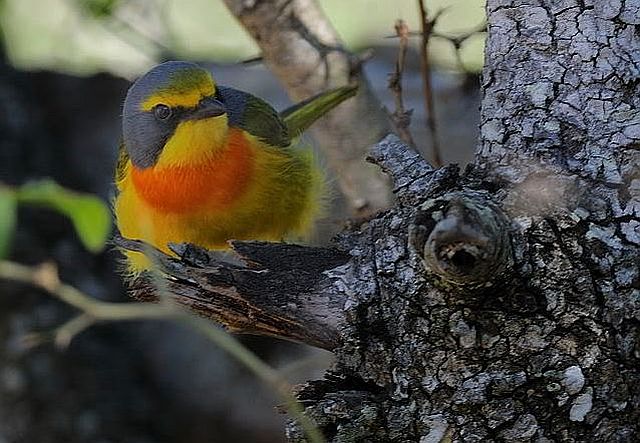
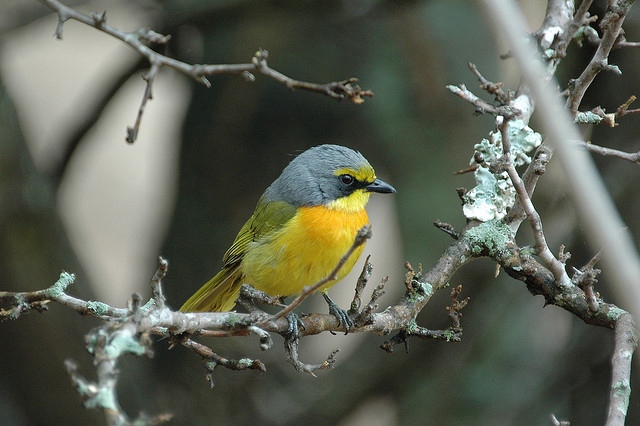 © Grumpy
© Grumpy
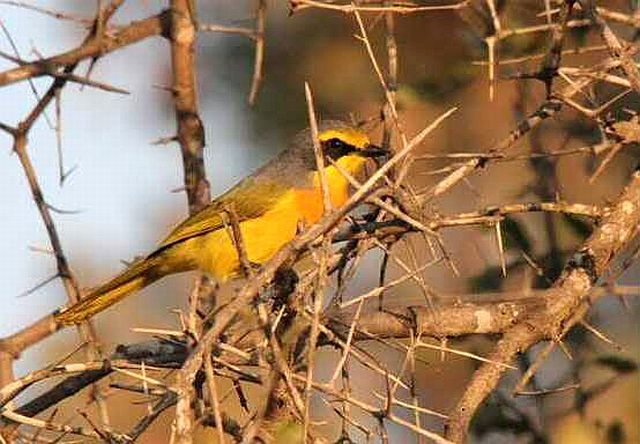 © pooky
© pooky
Links:
Species text Sabap1
Sabap2


 © Grumpy
© Grumpy © pooky
© pookyLinks:
Species text Sabap1
Sabap2
Dewi
What is the good of having a nice house without a decent planet to put it on? (H D Thoreau)
What is the good of having a nice house without a decent planet to put it on? (H D Thoreau)
Gorgeous Bushshrike
747. Gorgeous Bushshrike Telophorus viridis (Konkoit)
Order: Passeriformes. Family: Malaconotidae
Description
Size 18 cm; weight 37 g. Often heard, but can be difficult to see.
Adult male: Olive backed with red throat and black breast band. Forehead and eyebrow yellow, lores black. Orange-yellow belly with red/orange vent and red wash on undertail coverts.
Adult female: Similar to the male, but the black gorget is narrower and does not extend to the lores.
Distribution There are two separate populations - one along the coast of Tanzania and Kenya and the other in Mozambique, Zimbabwe's eastern Highlands, Limpopo Province, Mpumalanga and KwaZulu-Natal.
Taxonomy
Many authorities consider this to be the nominate subspecies of the Four-colored Bushshrike. Others consider both to be distinct species, in which case this species takes on the scientific name Telophorus viridis, having been distinguished first.
Habitat
Thick bush. Woodlands with dense undergrowth, especially riparian woodland. Also occurs in wooded drainage lines in thornveld, forest fringes, dune forest and coastal evergreen forest patches.
Diet
Mostly arthropods. It forages in the canopy of trees, gleaning insects from leaves and branches.
Breeding
Monogamous territorial nester. Both sexes construct the untidy nest, a shallow cup built of fine twigs, rootlets, leaf petioles and grass. It is usually placed on a horizontal branch or fork of a thorny tree. Egg-laying season peaks from October-December. It lays 1-3 blue eggs, which are incubated by both sexes for about 13-14 days. The chicks are fed by both parents and leave the nest after 12 days.
Call
A loud kong-kong-konweet. The contact call is a low, croaking gog or graagg. Listen to Bird Call.
Status
Fairly common resident.
Order: Passeriformes. Family: Malaconotidae
Description
Size 18 cm; weight 37 g. Often heard, but can be difficult to see.
Adult male: Olive backed with red throat and black breast band. Forehead and eyebrow yellow, lores black. Orange-yellow belly with red/orange vent and red wash on undertail coverts.
Adult female: Similar to the male, but the black gorget is narrower and does not extend to the lores.
Distribution There are two separate populations - one along the coast of Tanzania and Kenya and the other in Mozambique, Zimbabwe's eastern Highlands, Limpopo Province, Mpumalanga and KwaZulu-Natal.
Taxonomy
Many authorities consider this to be the nominate subspecies of the Four-colored Bushshrike. Others consider both to be distinct species, in which case this species takes on the scientific name Telophorus viridis, having been distinguished first.
Habitat
Thick bush. Woodlands with dense undergrowth, especially riparian woodland. Also occurs in wooded drainage lines in thornveld, forest fringes, dune forest and coastal evergreen forest patches.
Diet
Mostly arthropods. It forages in the canopy of trees, gleaning insects from leaves and branches.
Breeding
Monogamous territorial nester. Both sexes construct the untidy nest, a shallow cup built of fine twigs, rootlets, leaf petioles and grass. It is usually placed on a horizontal branch or fork of a thorny tree. Egg-laying season peaks from October-December. It lays 1-3 blue eggs, which are incubated by both sexes for about 13-14 days. The chicks are fed by both parents and leave the nest after 12 days.
Call
A loud kong-kong-konweet. The contact call is a low, croaking gog or graagg. Listen to Bird Call.
Status
Fairly common resident.
Dewi
What is the good of having a nice house without a decent planet to put it on? (H D Thoreau)
What is the good of having a nice house without a decent planet to put it on? (H D Thoreau)
Gorgeous Bushshrike Photos
747. Gorgeous Bushshrike Telophorus viridis (Konkoit)
Order: Passeriformes. Family: Malaconotidae
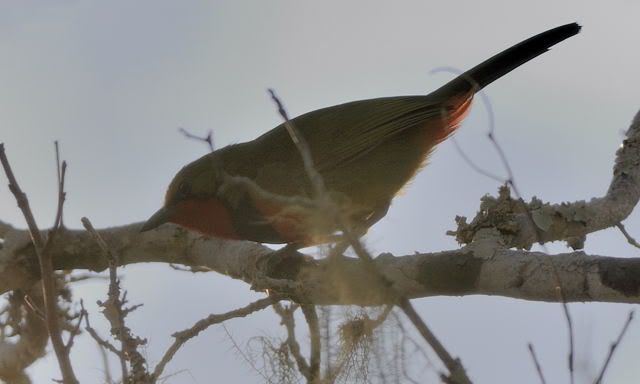
Male
Links:
Species text Sabap1
Sabap2: http://sabap2.adu.org.za/spp_summary.ph ... §ion=3
Roberts online
BirdInfo
Order: Passeriformes. Family: Malaconotidae

Male
Links:
Species text Sabap1
Sabap2: http://sabap2.adu.org.za/spp_summary.ph ... §ion=3
Roberts online
BirdInfo
Dewi
What is the good of having a nice house without a decent planet to put it on? (H D Thoreau)
What is the good of having a nice house without a decent planet to put it on? (H D Thoreau)
Bokmakierie
746. Bokmakierie Telophorus zeylonus (Bokmakierie)
Order: Passeriformes. Family: Malaconotidae
Description
A fairly large bushshrike. Length 23 cm, weight 48-76 g. The bright lemon yellow underparts and the broad black breast band are diagnostic. The vivid yellow tip to the dark green tail is conspicuous when the bird is in flight. The Bokmakierie has a grey crown and nape and an olive green back, the eyebrow, throat and underparts are yellow, the throat bordered by a broad black gorget. The tail is black, tipped with bright yellow and with green central rectrices (visible in flight). The eyes are brown, the hooked bill black and the legs bluish-grey. The sexes are similar in plumage, but the males are larger.
Juvenile lacks the black gorget.
Similar species: Distinguished from Yellow-throated Longclaw by grey and green upperparts.
Distribution
Near endemic to southern Africa, it occurs across South Africa excluding much of the Limpopo Province, extending into southern and western Namibia and south-western Angola. It also has an isolated population around the Chimanimani Mountain along the Zimbabwe/Mozambique border.
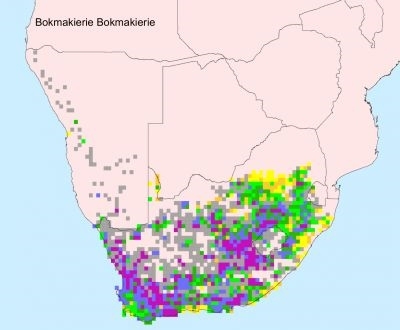
Habitat
It occupies a variety of habitats, however it prefers open areas with scattered shrubs and trees, such as dune scrub, succulent Karoo, renosterveld, Protea scrub, open bushveld, alien tree plantations, bushclump grassveld, orchards, vineyards, gardens, parks and bushy, rock-strewn hillsides.
Diet
An opportunistic feeder, it mainly eats insects but may also feed on lizards, snakes, birds and fruit. It catches most of its prey on the ground, rapidly pursuing before stunning and eating them. It also gleans insects from leaves and branches and occasionally hawks prey aerially.
Breeding
Bokmakieries are monogamous. Both sexes construct the nest, which is a cup made of small twigs, leaves, roots, tendrils, grass and bark, sometimes incorporating man-made materials such as twine, paper and cardboard. It is usually placed in a dense shrub, concealed by thick vegetation. Egg-laying season is year-round, peaking during August. It lays 2-5 bright green-blue eggs that are spotted with brown. Eggs are mainly incubated by the male in the day and the female at night, for a period of about 14-19 days. The young are brooded and fed by both adults, leaving the nest after about 15-21 days. The parents still tolerate their presence into the next breeding season, at which point they become independent.
Call
The paired birds almost invariably call in duet and have quite an extensive repertoire, but often containing a bok, bok, bok followed by a krrreee response. Hence the birds common name. Listen to Bird Call.
Status
Near endemic; common resident.
Order: Passeriformes. Family: Malaconotidae
Description
A fairly large bushshrike. Length 23 cm, weight 48-76 g. The bright lemon yellow underparts and the broad black breast band are diagnostic. The vivid yellow tip to the dark green tail is conspicuous when the bird is in flight. The Bokmakierie has a grey crown and nape and an olive green back, the eyebrow, throat and underparts are yellow, the throat bordered by a broad black gorget. The tail is black, tipped with bright yellow and with green central rectrices (visible in flight). The eyes are brown, the hooked bill black and the legs bluish-grey. The sexes are similar in plumage, but the males are larger.
Juvenile lacks the black gorget.
Similar species: Distinguished from Yellow-throated Longclaw by grey and green upperparts.
Distribution
Near endemic to southern Africa, it occurs across South Africa excluding much of the Limpopo Province, extending into southern and western Namibia and south-western Angola. It also has an isolated population around the Chimanimani Mountain along the Zimbabwe/Mozambique border.

Habitat
It occupies a variety of habitats, however it prefers open areas with scattered shrubs and trees, such as dune scrub, succulent Karoo, renosterveld, Protea scrub, open bushveld, alien tree plantations, bushclump grassveld, orchards, vineyards, gardens, parks and bushy, rock-strewn hillsides.
Diet
An opportunistic feeder, it mainly eats insects but may also feed on lizards, snakes, birds and fruit. It catches most of its prey on the ground, rapidly pursuing before stunning and eating them. It also gleans insects from leaves and branches and occasionally hawks prey aerially.
Breeding
Bokmakieries are monogamous. Both sexes construct the nest, which is a cup made of small twigs, leaves, roots, tendrils, grass and bark, sometimes incorporating man-made materials such as twine, paper and cardboard. It is usually placed in a dense shrub, concealed by thick vegetation. Egg-laying season is year-round, peaking during August. It lays 2-5 bright green-blue eggs that are spotted with brown. Eggs are mainly incubated by the male in the day and the female at night, for a period of about 14-19 days. The young are brooded and fed by both adults, leaving the nest after about 15-21 days. The parents still tolerate their presence into the next breeding season, at which point they become independent.
Call
The paired birds almost invariably call in duet and have quite an extensive repertoire, but often containing a bok, bok, bok followed by a krrreee response. Hence the birds common name. Listen to Bird Call.
Status
Near endemic; common resident.
Bokmakierie Photos
746. Bokmakierie Telophorus zeylonus
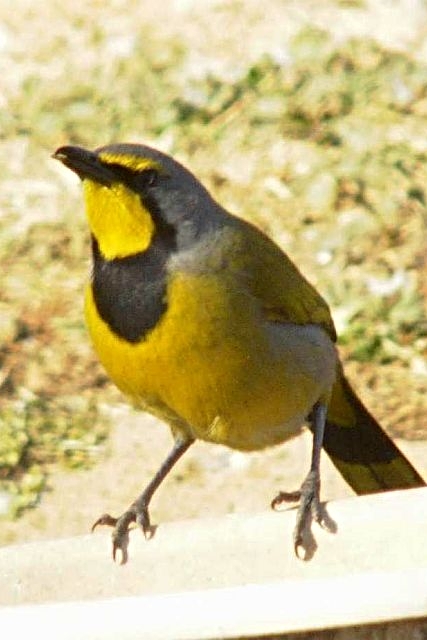 © H. erectus
© H. erectus
Garden in Gauteng
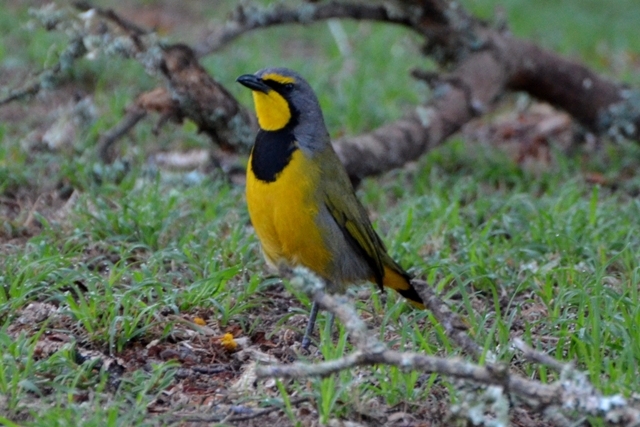 © Mel
© Mel
Bontebok National Park
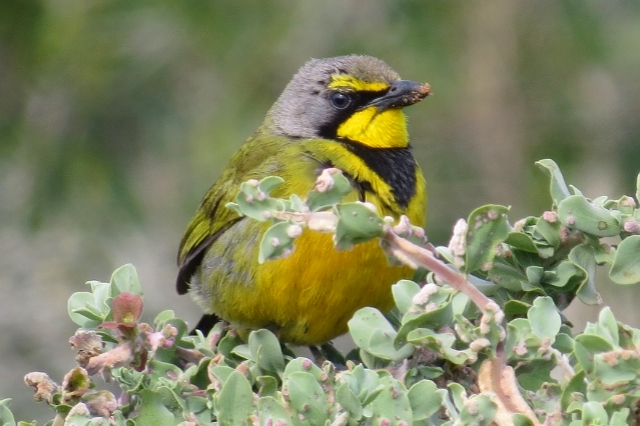 © Tina
© Tina
West Coast National Park, Western Cape
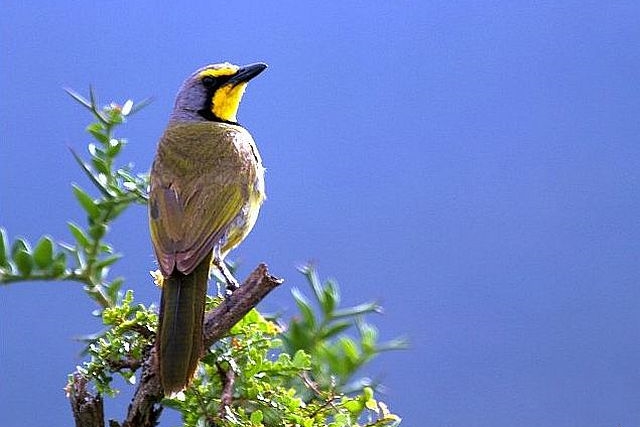 © Sharifa
© Sharifa
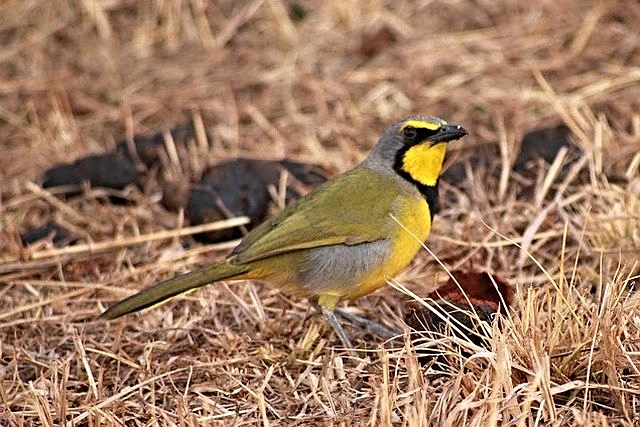 © Amoli
© Amoli
Rietvlei Nature Reserve, Gauteng
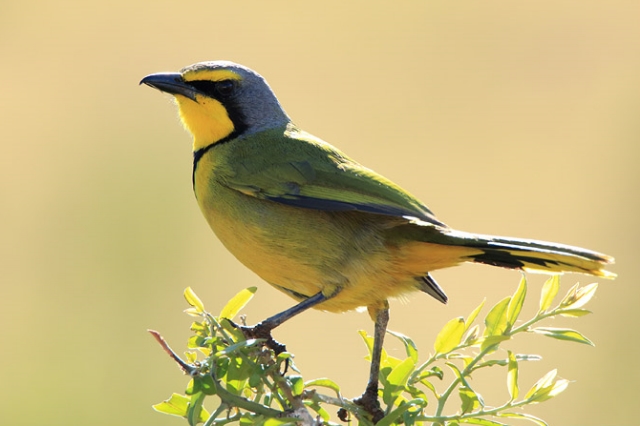 © PJL
© PJL
Addo Elephant National Park, Eastern Cape
Links:
http://sabap2.adu.org.za/docs/sabap1/746.pdf
http://sabap2.adu.org.za/species_info.p ... #menu_left
 © H. erectus
© H. erectusGarden in Gauteng
 © Mel
© MelBontebok National Park
 © Tina
© TinaWest Coast National Park, Western Cape
 © Sharifa
© Sharifa © Amoli
© AmoliRietvlei Nature Reserve, Gauteng
 © PJL
© PJLAddo Elephant National Park, Eastern Cape
Links:
http://sabap2.adu.org.za/docs/sabap1/746.pdf
http://sabap2.adu.org.za/species_info.p ... #menu_left
-
Michele Nel
- Posts: 1994
- Joined: Mon Sep 10, 2012 10:19 am
- Country: South Africa
- Location: Cape Town
- Contact:
Brown-crowned Tchagra
743. Brown-crowned Tchagra (formerly known as Three-streaked Tchagra) Tchagra australis (Rooivlerktjagra)
Order: Passeriformes. Family: Malaconotidae
Description
Size: 18 cm. Weight: 35 g. A shrike like bird with a not completely dark crown. Centre of crown is brown (not black). Sexes look alike.
Adult: Forehead, crown and nape brown. Supercilium white, bordered above by thin black line (diagnostic). Lores black, colour extending as eye stripe well behind eye. Sides of face and ear coverts brown. Back tawny brown. Rump and upper tail coverts greyish brown. Tail black, rectrices with broad white tips, width increasing outwards. Chin whitish buff. Throat to belly pale tawny, breast and flanks tinged greyish. Bill black. Eyes brown or purple-brown, with pale inner rim. Legs and feet grey.
The juvenile resembles the adult, but the crown is mottled brown, the eye stripe is brown and the bill is grey-brown.
Similar species: It is not easily distinguished from the Black-crowned Tchagra with which it overlaps widely, and the Southern Tchagra, with which it overlaps only slightly. The Black-crowned Tchagra is larger and has a black crown; the Southern Tchagra is also larger, lacks the thin black stripe above the eyebrow, has a darker brown crown, and lacks the dark stripe on the wing coverts.
Taxonomy
Nine subspecies have been recognised, in Southern Africa occour:
T. a. minor: South-eastern Kenya, Tanzania, Zambia to northern Zimbabwe and Mozambique
T. a. rhodesiensis: North-eastern Namibia to north-eastern Botswana, south-eastern Angola, extreme south-western Zambia
T. a. australis: Eastern South Africa, Swaziland, south-eastern Zimbabwe and southern Mozambique
T. a. damarensis: Namibia to extreme south-western Angola, Botswana and northern and north-central South Africa
Distribution
Widespread across Sub-Saharan Africa, absent only from the Congo Basin and areas of Tanzania. In southern Africa it is locally common from the North-West Province, Eastern Cape, KwaZulu-Natal and Mpumalanga through Mozambique, Zimbabwe, Botswana to much of Namibia.
Habitat
It is quite adaptable, occurring in a wide range of habitats including bushy savanna, arid thornbush, Miombo, Mopane and other broad-leaved woodlands, gallery forest and suburban gardens.
Diet
It mainly eats insects and their larvae, doing most of its foraging on the ground, plucking prey from the base of plants. It also gleans them off leaves and branches in the canopy and occasionally catches prey aerially.
Breeding
It is a monogamous, solitary nester with males vigorously defending their territories using flight displays and calling. Both sexes construct the nest, which is a shallow cup made of rootlets, fine twigs, coarse grass and leaf stems, cemented with spider web. It is usually placed in a fork or horizontal branch of a bush, well concealed by foliage. Egg-laying season is from about September-March, peaking from October-December. Eggs are white or pinkish white, spotted and blotched with brown and grey concentrated at thick end. It lays 2-4 eggs, which are incubated mainly by the female for roughly 14-17 days. The male doesn't do much incubating, but he defends their territory and often feeds his mate at the nest. The chicks leave the nest at about 13-16 days old, after which they remain with their parents for at least 5 months.
Call
In flight display rises with loud bursts of quivering wings, just above vegetation, prrr prrr prrr prrr, followed by gliding descent with spread tail and about 15 melodious double whistles dropping in tone but rising in volume, pa-reeu pa-reeu pa-reeu, etc.; sharp chirrp, chirrp alarm and anxiety calls. Listen to Bird Call.
Status
Common resident.
Order: Passeriformes. Family: Malaconotidae
Description
Size: 18 cm. Weight: 35 g. A shrike like bird with a not completely dark crown. Centre of crown is brown (not black). Sexes look alike.
Adult: Forehead, crown and nape brown. Supercilium white, bordered above by thin black line (diagnostic). Lores black, colour extending as eye stripe well behind eye. Sides of face and ear coverts brown. Back tawny brown. Rump and upper tail coverts greyish brown. Tail black, rectrices with broad white tips, width increasing outwards. Chin whitish buff. Throat to belly pale tawny, breast and flanks tinged greyish. Bill black. Eyes brown or purple-brown, with pale inner rim. Legs and feet grey.
The juvenile resembles the adult, but the crown is mottled brown, the eye stripe is brown and the bill is grey-brown.
Similar species: It is not easily distinguished from the Black-crowned Tchagra with which it overlaps widely, and the Southern Tchagra, with which it overlaps only slightly. The Black-crowned Tchagra is larger and has a black crown; the Southern Tchagra is also larger, lacks the thin black stripe above the eyebrow, has a darker brown crown, and lacks the dark stripe on the wing coverts.
Taxonomy
Nine subspecies have been recognised, in Southern Africa occour:
T. a. minor: South-eastern Kenya, Tanzania, Zambia to northern Zimbabwe and Mozambique
T. a. rhodesiensis: North-eastern Namibia to north-eastern Botswana, south-eastern Angola, extreme south-western Zambia
T. a. australis: Eastern South Africa, Swaziland, south-eastern Zimbabwe and southern Mozambique
T. a. damarensis: Namibia to extreme south-western Angola, Botswana and northern and north-central South Africa
Distribution
Widespread across Sub-Saharan Africa, absent only from the Congo Basin and areas of Tanzania. In southern Africa it is locally common from the North-West Province, Eastern Cape, KwaZulu-Natal and Mpumalanga through Mozambique, Zimbabwe, Botswana to much of Namibia.
Habitat
It is quite adaptable, occurring in a wide range of habitats including bushy savanna, arid thornbush, Miombo, Mopane and other broad-leaved woodlands, gallery forest and suburban gardens.
Diet
It mainly eats insects and their larvae, doing most of its foraging on the ground, plucking prey from the base of plants. It also gleans them off leaves and branches in the canopy and occasionally catches prey aerially.
Breeding
It is a monogamous, solitary nester with males vigorously defending their territories using flight displays and calling. Both sexes construct the nest, which is a shallow cup made of rootlets, fine twigs, coarse grass and leaf stems, cemented with spider web. It is usually placed in a fork or horizontal branch of a bush, well concealed by foliage. Egg-laying season is from about September-March, peaking from October-December. Eggs are white or pinkish white, spotted and blotched with brown and grey concentrated at thick end. It lays 2-4 eggs, which are incubated mainly by the female for roughly 14-17 days. The male doesn't do much incubating, but he defends their territory and often feeds his mate at the nest. The chicks leave the nest at about 13-16 days old, after which they remain with their parents for at least 5 months.
Call
In flight display rises with loud bursts of quivering wings, just above vegetation, prrr prrr prrr prrr, followed by gliding descent with spread tail and about 15 melodious double whistles dropping in tone but rising in volume, pa-reeu pa-reeu pa-reeu, etc.; sharp chirrp, chirrp alarm and anxiety calls. Listen to Bird Call.
Status
Common resident.
-
Michele Nel
- Posts: 1994
- Joined: Mon Sep 10, 2012 10:19 am
- Country: South Africa
- Location: Cape Town
- Contact:
Brown-crowned Tchagra Photos
743. Brown-crowned Tchagra Tchagra australis
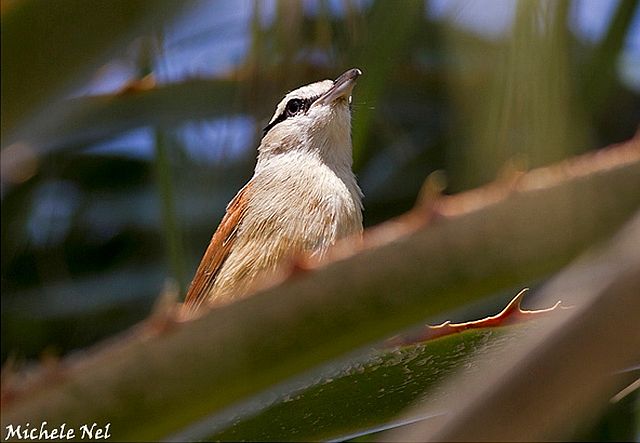
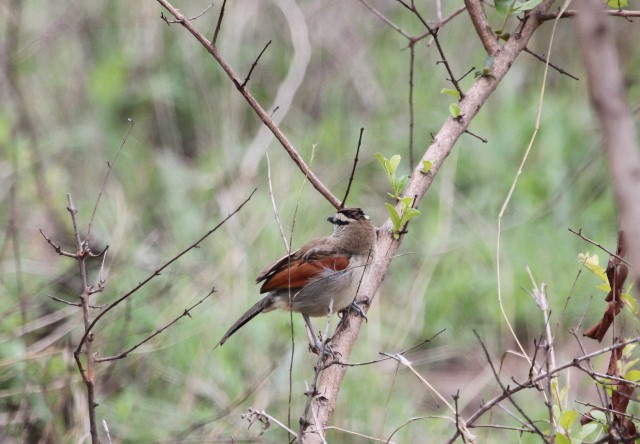 © nan
© nan
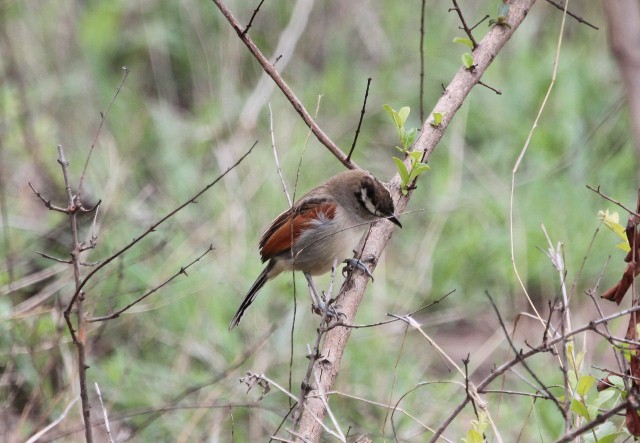 © nan
© nan
 © Dewi
© Dewi
 © Amoli
© Amoli
Links:
Species text Sabap1
Sabap2
Biodiversity Explorer

 © nan
© nan © nan
© nan © Dewi
© Dewi © Amoli
© AmoliLinks:
Species text Sabap1
Sabap2
Biodiversity Explorer
- Mel
- Global Moderator
- Posts: 26737
- Joined: Sat May 19, 2012 12:31 pm
- Country: Germany
- Location: Föhr
- Contact:
Southern Tchagra
742. Southern Tchagra Tchagra tchagra (Grysborstjagra)
Order: Passeriformes. Family: Malaconotidae
Description
17–21 cm. Has a brown crown, grey to white broad supercilium and black eyestripe. The back is olive brown and the rump is olive grey. The tail is black and brown, tipped white, and the wings mainly rufous and olive-brown. The underparts are grey except for the the chin and throat, which are greyish white. The longish bill is black. The sexes are similar.
The juvenile is a duller version of the adult, but more olive above. It has a buff stripe through the eye and the tail is tipped buff.
Similar species: This species is similar to the Black-crowned Tchagra, but that species is larger, and the adult has a black rather than brown crown. It differs from the similar Brown-crowned Tchagra by having a longer, heavier bill and by lacking conspicuous black stripes bordering its buff eyebrow stripe, by its plain brown crown without black edges and by dusky white underparts.
Distribution
Endemic to Southern and eastern South Africa and western Swaziland, occurring from the Western Cape to KwaZulu-Natal bordering on Mpumalanga. It is common throughout most of its range, although it is more localized in Mpumalanga, Swaziland and eastern KwaZulu-Natal.
Taxonomy
There are three fairly similar subspecies of Southern Tchagra in South Africa. Nominate T. t. tchagra of the Western Cape has the darkest underparts and longest bill. T. t. caffrariae has paler underparts and the shortest bill, and T. t. natalensis of eastern South Africa and Swaziland has the palest underparts and a reddish-brown crown.
Habitat
Thickets in the riverine or coastal bush, forest edges, thornveld or dense fynbos. It mainly occupies coastal, thorny thickets, edges of coastal dune forest, tangled fynbos and dense Acacia stands.
Diet
Invertebrates, fruit, seeds and molluscs.
Breeding
Monogamous and territorial. The nest is probably built by both sexes, and consists of a shallow cup built of fine plant stems, twigs and rootlets, the inside lined with finer rootlets and hair. In the Western Cape it is usually placed in the fork of thick scrub or bush, but further east it also puts it at the base of Aloe ferox (Bitter aloe) as well as in tangled creepers growing over cabbage-tree (Cussonia). Eggs are laid August to December. It lays 2-3 white eggs with coloured dots and streaks, which are incubated for about 15-16 days. The chicks are brooded almost constantly for the first 8-10 days or so, after which brooding almost completely ceases. They are cared for by both parents, leaving the nest after about 13-16 days.
Call
The male Southern Tchagra has a descending whistling song, ttttrtr te te te teuuu given in its display flight or from a perch. The female responds with a trilled tzerrrrrrrr. Listen to Bird Call.
Status
A common resident.
Order: Passeriformes. Family: Malaconotidae
Description
17–21 cm. Has a brown crown, grey to white broad supercilium and black eyestripe. The back is olive brown and the rump is olive grey. The tail is black and brown, tipped white, and the wings mainly rufous and olive-brown. The underparts are grey except for the the chin and throat, which are greyish white. The longish bill is black. The sexes are similar.
The juvenile is a duller version of the adult, but more olive above. It has a buff stripe through the eye and the tail is tipped buff.
Similar species: This species is similar to the Black-crowned Tchagra, but that species is larger, and the adult has a black rather than brown crown. It differs from the similar Brown-crowned Tchagra by having a longer, heavier bill and by lacking conspicuous black stripes bordering its buff eyebrow stripe, by its plain brown crown without black edges and by dusky white underparts.
Distribution
Endemic to Southern and eastern South Africa and western Swaziland, occurring from the Western Cape to KwaZulu-Natal bordering on Mpumalanga. It is common throughout most of its range, although it is more localized in Mpumalanga, Swaziland and eastern KwaZulu-Natal.
Taxonomy
There are three fairly similar subspecies of Southern Tchagra in South Africa. Nominate T. t. tchagra of the Western Cape has the darkest underparts and longest bill. T. t. caffrariae has paler underparts and the shortest bill, and T. t. natalensis of eastern South Africa and Swaziland has the palest underparts and a reddish-brown crown.
Habitat
Thickets in the riverine or coastal bush, forest edges, thornveld or dense fynbos. It mainly occupies coastal, thorny thickets, edges of coastal dune forest, tangled fynbos and dense Acacia stands.
Diet
Invertebrates, fruit, seeds and molluscs.
Breeding
Monogamous and territorial. The nest is probably built by both sexes, and consists of a shallow cup built of fine plant stems, twigs and rootlets, the inside lined with finer rootlets and hair. In the Western Cape it is usually placed in the fork of thick scrub or bush, but further east it also puts it at the base of Aloe ferox (Bitter aloe) as well as in tangled creepers growing over cabbage-tree (Cussonia). Eggs are laid August to December. It lays 2-3 white eggs with coloured dots and streaks, which are incubated for about 15-16 days. The chicks are brooded almost constantly for the first 8-10 days or so, after which brooding almost completely ceases. They are cared for by both parents, leaving the nest after about 13-16 days.
Call
The male Southern Tchagra has a descending whistling song, ttttrtr te te te teuuu given in its display flight or from a perch. The female responds with a trilled tzerrrrrrrr. Listen to Bird Call.
Status
A common resident.
God put me on earth to accomplish a certain amount of things. Right now I'm so far behind that I'll never die.
- Mel
- Global Moderator
- Posts: 26737
- Joined: Sat May 19, 2012 12:31 pm
- Country: Germany
- Location: Föhr
- Contact:
Southern Tchagra Photos
742. Southern Tchagra Tchagra tchagra

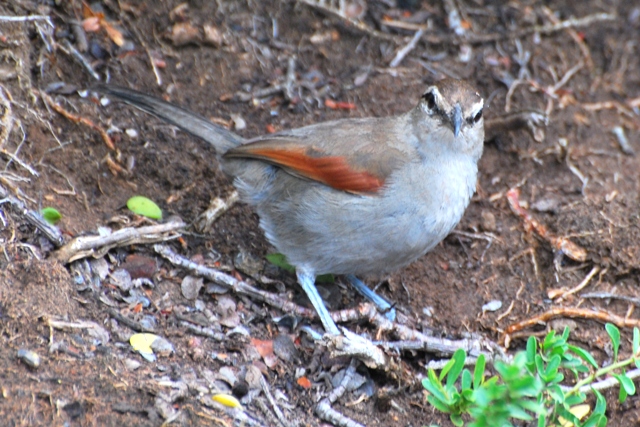
Links:
Species text in The Atlas of Southern African Birds
Sabap2


Links:
Species text in The Atlas of Southern African Birds
Sabap2
God put me on earth to accomplish a certain amount of things. Right now I'm so far behind that I'll never die.


